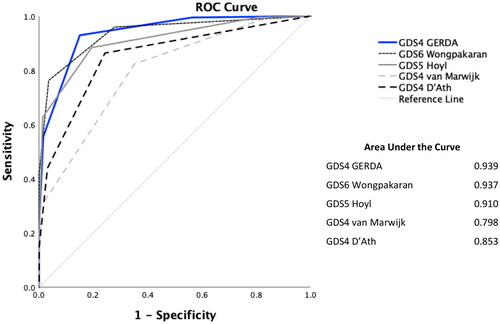Figures & data
Table 1. Characteristics of the participants and comparison with previous studies and of subgroups depending on depression being indicated or not according to total GDS-15 score with cut off of ≥ 5 points as indicating depression.
Figure 1. Item characteristic curves illustrating the results of the two-parameter item response theory analysis of A) every item of GDS-15 and B) of the items 3, 8, 12 and 13 which were included in the suggested short version, GDS-4 GERDA. The vertical line representing the 15-item Geriatric depression scale (GDS-15) cut off of ≥ 5 points as indicating depression.

Table 2. Item parameters and reliability analysis of Geriatric Depression Scale in the present study and comparison of the suggested 4-item short version (GDS-4 GERDA) with previous versions. The table is sorted according to item difficulty from lowest to highest. Cronbach’s alpha of the whole scale was 0.736.
Figure 2. Receiver operating characteristic (ROC) curves for the suggested short version GDS-4 GERDA in comparison to other versions suggested in previous research: GDS-6 Wongpakaran, GDS-4 D’Ath, GDS-4 van Marwijk, and GDS-5 Hoyl. The ROC curves were drawn using the 15-item Geriatric Depression Scale with cut-off of ≥5 as indicating depression as gold standard.

Table 3. Sensitivity, specificity, positive predictive value and negative predictive value for the suggested 4-item short version, GDS-4 GERDA, for indicating depression at possible cut-off values.
